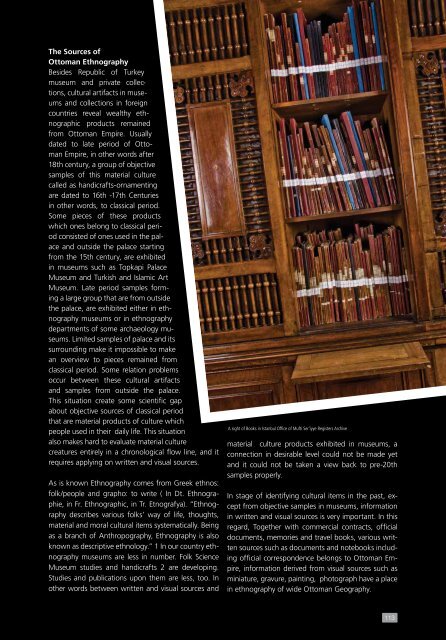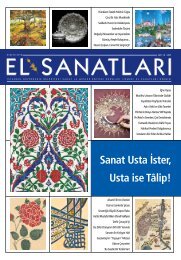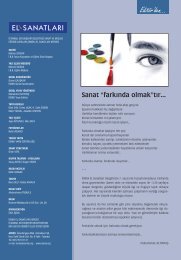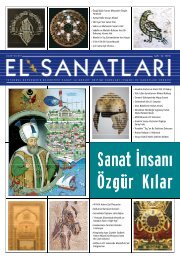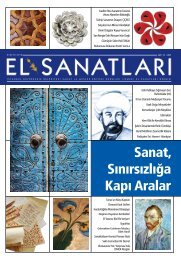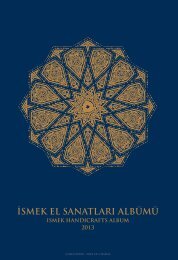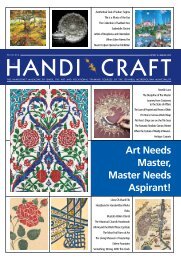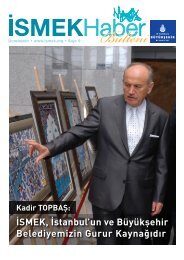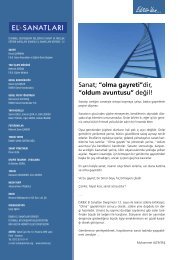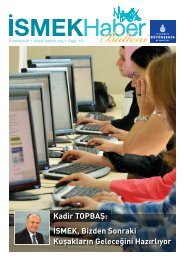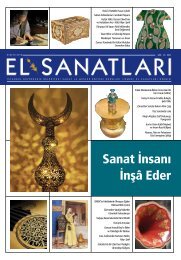You also want an ePaper? Increase the reach of your titles
YUMPU automatically turns print PDFs into web optimized ePapers that Google loves.
The Sources ofOttoman EthnographyBesides Republic of Turkeymuseum and private collections,cultural artifacts in museumsand collections in foreigncountries reveal wealthy ethnographicproducts remainedfrom Ottoman Empire. Usuallydated to late period of OttomanEmpire, in other words after18th century, a group of objectivesamples of this material culturecalled as handicrafts-ornamentingare dated to 16th -17th Centuriesin other words, to classical period.Some pieces of these productswhich ones belong to classical periodconsisted of ones used in the palaceand outside the palace startingfrom the 15th century, are exhibitedin museums such as Topkapi PalaceMuseum and Turkish and Islamic ArtMuseum. Late period samples forminga large group that are from outsidethe palace, are exhibited either in ethnographymuseums or in ethnographydepartments of some archaeology museums.Limited samples of palace and itssurrounding make it impossible to makean overview to pieces remained fromclassical period. Some relation problemsoccur between these cultural artifactsand samples from outside the palace.This situation create some scientific gapabout objective sources of classical periodthat are material products of culture whichpeople used in their daily life. This situationalso makes hard to evaluate material culturecreatures entirely in a chronological flow line, and itrequires applying on written and visual sources.As is known Ethnography comes from Greek ethnos:folk/people and grapho: to write ( In Dt. Ethnographie,in Fr. Ethnographic, in Tr. Etnografya). “Ethnographydescribes various folks’ way of life, thoughts,material and moral cultural items systematically. Beingas a branch of Anthropography, Ethnography is alsoknown as descriptive ethnology.” 1 In our country ethnographymuseums are less in number. Folk ScienceMuseum studies and handicrafts 2 are developing.Studies and publications upon them are less, too. Inother words between written and visual sources andA sight of Books in Istanbul Office of Mufti Ser'iyye Registers Archivematerial culture products exhibited in museums, aconnection in desirable level could not be made yetand it could not be taken a view back to pre-20thsamples properly.In stage of identifying cultural items in the past, exceptfrom objective samples in museums, informationin written and visual sources is very important. In thisregard, Together with commercial contracts, officialdocuments, memories and travel books, various writtensources such as documents and notebooks includingofficial correspondence belongs to Ottoman Empire,information derived from visual sources such asminiature, gravure, painting, photograph have a placein ethnography of wide Ottoman Geography.113


